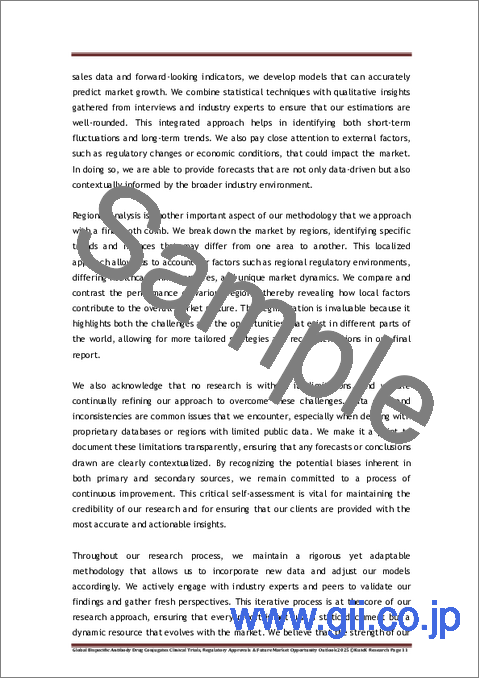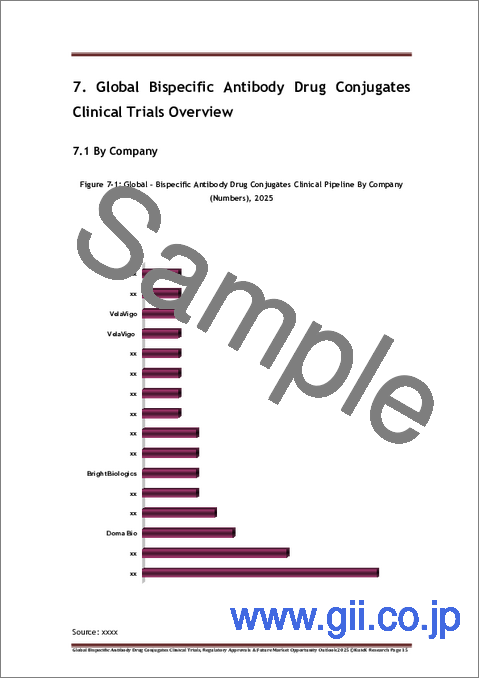|
|
市場調査レポート
商品コード
1797410
二重特異性抗体薬物複合体の世界市場:臨床試験、開発プラットフォーム、競合情勢と市場の機会(2025年)Global Bispecific Antibody Drug Conjugates Clinical Trials, Development Platforms, Competitive Landscape & Market Opportunity Insight 2025 |
||||||
|
|||||||
| 二重特異性抗体薬物複合体の世界市場:臨床試験、開発プラットフォーム、競合情勢と市場の機会(2025年) |
|
出版日: 2025年08月01日
発行: KuicK Research
ページ情報: 英文 180 Pages
納期: 即日から翌営業日
|
全表示
- 概要
- 図表
- 目次
二重特異性抗体薬物複合体の世界市場:臨床試験、開発プラットフォーム、競合情勢と市場の機会(2025年)の調査結果とハイライト
- 2029年までに最初の二重特異性抗体薬物複合体が利用可能になる見込み
- 臨床試験中の二重特異性抗体薬物複合体:100超
- 二重特異性抗体薬物複合体の臨床試験インサイト:企業別、国別、適応症別、相別
- 世界の二重特異性抗体薬物複合体の開発状況を支配する中国:60以上の複合体
- 二重特異性抗体薬物複合体の大半はがん:40超
- 二重特異性抗体薬物複合体の開発プラットフォームに関する洞察
- 競合情勢
二重特異性抗体薬物複合体の必要性と当レポートの意義
二重特異性抗体薬物複合体(BsADC)は、二重特異性抗体の特異性と従来の抗体薬物複合体(ADC)の標的細胞毒性を融合させた、がん治療における新しい波です。従来のADCは効果的でしたが、標的外毒性や腫瘍浸透性の低下(特に固形がん)により阻害される傾向となっています。BsADCは、2つの異なる抗原を同時にターゲティングすることにより、これらの問題を解決します。このデュアルターゲティングにより、腫瘍選択性の向上、ドラッグデリバリーの改善、オフターゲティング効果の減少が可能となります。二特異性抗体薬物複合体は、技術が成熟するにつれて、特に乳がん、肺がん、膵がんなどの治療が困難ながん患者の治療成績に大きな改善をもたらすと思われます。
当レポートは、二重特異性抗体薬物複合体の包括的な市場分析を提供し、最新の臨床試験のアップデート、業界リーダー、技術的進歩、進歩を形作る共同パートナーシップについて論じています。また、このような改良が将来のがん治療にどのような影響を与えるかについての洞察も提供しています。
レポートに含まれる臨床試験に関する洞察
臨床試験は、二重特異性抗体薬物複合体の開発において、これらの新たな治療法の安全性、有効性、忍容性を確立する上で中心的な役割を果たします。当レポートでは、現在進行中および今後の臨床試験の動向を調査し、がん領域における次世代治療となる可能性を秘めた、パイプライン中の最も有望な候補化合物を取り上げています。その一例として、EGFR変異NSCLCに対する二重特異性ADCであるIzalontamab brengitecan(Iza-bren)は第3相試験中であり、すでにいくつかの画期的治療薬指定を受けています。このセクションで提供される情報は、具体的には臨床試験のステージ、スポンサー、地域分布、技術提供者、共同研究者、ライセンスホルダーから構成されます。
二重特異性抗体薬物複合体の研究開発に積極的な主要企業
二重特異性抗体薬物複合体の市場環境は、老舗製薬会社、専門・新興バイオテクノロジー企業の両方が力強く前進している、競争の激しい市場です。AstraZeneca、Amgen、Bristol Myers Squibb、イInnovent Biologicsなどの開発大手は、固形がんを治療する二重特異性抗体薬物複合体の候補を積極的に開発しています。これらの企業は、現在のADC技術を改良するだけでなく、特異性を高め副作用を減らすために新しい二重特異性抗体フォーマットの研究も行っています。
Duality Biotherapeutics、Allink Biotherapeutics、Jiangsu Alphamab Biopharmaceuticalsなどの専門企業も、画期的なプラットフォームと新規の二重特異性デザインに注力しており、遅れをとっていないです。これらの企業が差別化された候補薬を開発するにつれ、二重特異性抗体薬物複合体の分野での競合はますます激しくなっており、各社は非常に強力な治療薬で最初に市場投入しようと競争しています。
技術プラットフォーム、共同研究、契約
二特異性抗体薬物複合体の有効性は、正確な抗体工学、効果的な薬物複合化、腫瘍ターゲットの改善を促進する最先端の技術プラットフォームにかかっています。OmniAbやDualityBioのような組織は、二重特異性抗体の設計を容易にする革新的なプラットフォームを創り出す最前線にいます。OmniAbの抗体探索プラットフォームとVeraxa BiotechのADCリンカー技術との組み合わせは、二特異性抗体薬物複合体の開発を最大限に促進することを目的とした、集中的パートナーシップの動向を捉えています。Bristol Myers SquibbとSystImmuneのような戦略的提携は、開発のスピードアップのために企業がリソースを共有することで、ますます広まっています。このような提携は、BsADCの臨床開発をより迅速に進めるために必要であり、相互補完的なスキルを活用することで、より強力ながん治療薬をもたらすことができます。
二重特異性抗体薬物複合体セグメントの今後の方向性を示すレポート
当レポートは、二重特異性抗体薬物複合体市場が、技術の進歩と臨床的成功の積み重ねによって力強い成長を遂げ、バラ色の未来を予見しています。調査チームは、複数のがん抗原や腫瘍微小環境の経路を標的とするマルチターゲット戦略に重点を置きながら、二重特異性抗体薬物複合体の設計を最適化し続けると思われます。また、二重特異性抗体薬物複合体の将来性に対する投資家の楽観的な見方が強まっていることを反映して、金融投資も市場を同じ方向に押し上げています。技術的進歩、提携関係、財政的支援の相乗効果により、BsADCは腫瘍学の未来の最前線に位置しています。
全体として、二重特異性ADC市場は、有望な治療が臨床試験を通じて進展し、新たな技術がその有効性を向上させることで、大きな成長の尖端にあります。当レポートは、がん治療に革命をもたらし、これまで治療不可能であったがん患者に新たな希望をもたらすBsADCの有望な可能性に光を当てています。
目次
第1章 二重特異性抗体薬物複合体の構想と開発の現状
- 概要
- 他の免疫療法との比較
第2章 二重特異性抗体薬物複合体の必要性
第3章 二重特異性抗体薬物複合体- 設計と作用機序
- 一般的な構造と設計
- 作用機序
第4章 世界の二重特異性抗体薬物複合体市場の洞察
- 現在の市場シナリオ
- 将来の市場機会
第5章 二重特異性抗体薬物複合体市場分析、地域別
- 中国
- 米国
- 欧州
- 韓国
第6章 二重特異性抗体薬物複合体- 適応症別の応用と開発
- 乳がん
- 消化器がん
- 肺がん
- 泌尿器がん
- 婦人科がん
第7章 世界の二重特異性抗体薬物複合体の臨床試験の概要
- 企業別
- 国別
- 適応症別
- 相別
第8章 二重特異性抗体薬物複合体の臨床試験:企業、国、適応症、相別
- 研究
- 前臨床
- 第I別
- 第I/II別
- 第II別
- 第III別
第9章 二重特異性抗体薬物複合体の開発に使用されるプラットフォーム技術
この章では、二重特異性抗体薬物複合体の開発に使用される15以上のプラットフォーム技術について包括的な洞察を提供します。
第10章 競合情勢
- Almac Discovery
- Alphamab Oncology
- Amgen
- ArbeleBio
- AstraZeneca
- Beijing Biocytogen
- BiVictriX Therapeutics
- Bright Biologics
- Corellia AI
- CStone Pharmaceuticals
- Debiopharm
- Doma Bio
- DualityBio
- Enduring Biotech
- Genmab
- InduPro
- Innovent Biologics
- Kanaph Therapeutics
- ProEn Therapeutics
- Synaffix
List of Figures
- Figure 1-1: Future Directions In BsADC Development
- Figure 1-2: Limitations Of Convectional Immunotherapies Addressable By BsADCs
- Figure 3-1: Bispecific Antibody Drug Conjugate - General Structure
- Figure 3-2: Bispecific Antibody Drug Conjugate - General Mechanism of Action
- Figure 4-1: Bispecific Antibody Drug Conjugate Market forecast - Projections For First 12 & 24 Months Post-Approval Of First Drug (US$ Million)
- Figure 4-2: Key Future Opportunities
- Figure 6-1: BL-B01D1-306 Phase III (NCT06343948) Study - Initiation & Estimated Completion Year
- Figure 6-2: BL-B01D1-307 Phase III (NCT06382142) Study - Initiation & Estimated Completion Year
- Figure 6-3: BL-B01D1-204-04 Phase II (NCT06471205) Study - Initiation & Estimated Completion Year
- Figure 6-4: BL-B01D1-SI-B003-201-04 Phase II (NCT06042894) Study - Initiation & Estimated Completion Year
- Figure 6-5: BL-B01D1-LUNG-101 Phase I (NCT05983432) Study - Initiation & Estimated Completion Year
- Figure 6-6: BL-B01D1-104 Phase I (NCT05470348) Study - Initiation & Estimated Completion Year
- Figure 6-7: KM501-1001 Phase I (NCT05804864) Study - Initiation & Estimated Completion Year
- Figure 6-8: BL-B01D1-SI-B003-201-05 Phase II (NCT06008054) Study - Initiation & Estimated Completion Year
- Figure 6-9: BL-B01D1-103 Phase I (NCT05262491) Study - Initiation & Estimated Completion Year
- Figure 6-10: BL-B01D1-302 Phase III (NCT06382129) Study - Initiation & Estimated Completion Year
- Figure 6-11: BL-B01D1-301 Phase III (NCT06382116) Study - Initiation & Estimated Completion Year
- Figure 6-12: BL-B01D1-304 Phase III (NCT06500026) Study - Initiation & Estimated Completion Year
- Figure 6-13: DM001001 Phase II (NCT06475937) Study - Estimated Initiation & Estimated Completion Year
- Figure 6-14: CIBI334A101 Phase I/II (NCT05774873) Study - Estimated Initiation & Estimated Completion Year
- Figure 6-15: BL-B01D1-201 Phase II (NCT05785039) Study - Initiation & Estimated Completion Year
- Figure 6-16: BL-B01D1-102 Phase I (NCT05393427) Study - Initiation & Estimated Completion Year
- Figure 6-17: BL-B01D1-SI-B003-201-08 Phase II (NCT05990803) Study - Initiation & Estimated Completion Year
- Figure 6-18: BL-B01D1-202 Phase Ib/II (NCT05803018) Study - Initiation & Estimated Completion Year
- Figure 6-19: IMGN151-1001 Phase I (NCT05527184) Study - Initiation & Estimated Completion Year
- Figure 6-20: JSKN003-102 Phase I/II (NCT05744427) Study - Initiation & Estimated Completion Year
- Figure 7-1: Global - Bispecific Antibody Drug Conjugates Clinical Pipeline By Company (Numbers), 2025
- Figure 7-2: Global - Bispecific Antibody Drug Conjugates Clinical Pipeline By Country (Numbers), 2025
- Figure 7-3: Global - Bispecific Antibody Drug Conjugates Clinical Pipeline By Indication (Numbers), 2025
- Figure 7-4: Global - Bispecific Antibody Drug Conjugates Clinical Pipeline By Phase (Numbers), 2025
- Figure 9-1: ArbeleBio - Unnamed ADC Platform
- Figure 9-2: BiVictriX - Bi-Cygni Therapeutics
- Figure 9-3: Duality Biologics - DITAC Platform
- Figure 9-4: Duality Biologics - DITAC Platform
- Figure 9-5: LigaChem Biosciences - ConjuALL
- Figure 9-6: LigaChem Biosciences - Conjugation Method
- Figure 9-7: LigaChem Biosciences - B-Glucuronide Linker
- Figure 9-8: LigaChem Biosciences - B-Glucuronide Linker
- Figure 9-9: ProEn Therapeutics - ArtBody(TM) ADC technology
- Figure 9-10: Synaffix - Proprietary Technologies
List of Tables
- Table 1-1: BsADC vs. Conventional ADC
- Table 1-2: Bispecific Antibody Formats
- Table 4-1: Bispecific Antibody Drug Conjugate Market - Recent Collaborations
- Table 6-1: BL-B01D1: Clinical Trials Underway For Lung Cancer
Global Bispecific Antibody Drug Conjugates Clinical Trials, Development Platforms, Competitive Landscape & Market Opportunity Insight 2025 Report Findings & Highlights:
- First Bispecific Antibody Drug Conjugate Availability Expected By 2029
- Insight On Bispecific Antibody Drug Conjugates In clinical Trials: > 100
- Bispecific Antibody Drug Conjugates Clinical Trials Insight By Company, Country, Indication & Phase
- China Dominating Global Bispecific Antibody Drug Conjugates Development Landscape: > 60 Conjugates
- Majority Of Bispecific Antibody Drug Conjugates Cancer: > 40
- Insight On Bispecific Antibody Drug Conjugates Development Platforms
- Competitive Landscape
Need for Bispecific Antibody-Drug Conjugate & Why This Report?
Bispecific antibody drug conjugates (BsADCs) are a new wave in cancer treatment, fusing the specificity of bispecific antibodies with the targeted cytotoxicity of traditional antibody drug conjugates (ADCs). Whereas classic ADCs have been effective, they tend to be hampered by off-target toxicity and reduced tumor penetration, especially in solid tumors. BsADCs solve these problems through the simultaneous targeting of two distinct antigens; this dual targeting allows for enhanced tumor selectivity, improved drug delivery, and fewer off-targeting effects. Bispecific antibody drug conjugates will go on to provide significant improvements in outcomes for patients, particularly those with hard-to-treat cancers such as breast, lung, and pancreatic cancers, as the technology matures.
This report offers an comprehensive market analysis of Bispecific antibody drug conjugates, discussing the most recent clinical trial updates, industry leaders, technological advancements, and collaborative partnerships shaping progress. It also offers insight into how such improvements are expected to impact cancer treatment in the future.
Clinical Trials Insight Included In Report
Clinical trials are central to the development of Bispecific antibody drug conjugates since they establish the safety, efficacy, and tolerability of these emerging treatments. This report explores the existing trend of ongoing and future clinical trials and highlights the most promising candidates in the pipeline that have the potential to be next-generation treatments in oncology. An example of this is Izalontamab brengitecan (Iza-bren), a bispecific ADC for EGFR-mutated NSCLC, in Phase 3 trials and already received several Breakthrough Therapy Designations. The information provided in this section specifically comprises stages of trials, sponsors, geographical distribution, technology providers, collaborators and license holders.
Major Companies Active In R&D of Bispecific Antibody Drug Conjugate
Bispecific antibody drug conjugates landscape is a highly competitive market with both well-established pharmaceutical companies and specialty and startup biotechs advancing strongly. Leaders such as AstraZeneca, Amgen, Bristol Myers Squibb, and Innovent Biologics are aggressively developing Bispecific antibody drug conjugates candidates to treat solid tumors. The players are not only refining current ADC technologies but also investigation of new bispecific antibody formats to enhance specificity and decrease side effects.
Specialty firms such as Duality Biotherapeutics, Allink Biotherapeutics, and Jiangsu Alphamab Biopharmaceuticals are not far behind, with a focus on groundbreaking platforms and novel bispecific designs. As these firms develop differentiated candidates, the competition in the bispecific antibody drug conjugates arena is becoming increasingly fierce, with companies racing to make the first-to-market with very potent therapies.
Technology Platforms, Collaborations & Agreements
The efficacy of bispecific antibody drug conjugates largely rests on state-of-the-art technology platforms that facilitate accurate antibody engineering, effective drug conjugation, and improved tumor targeting. Organizations such as OmniAb and DualityBio are at the forefront of creating innovative platforms to facilitate bispecific antibody design. OmniAb's antibody discovery platform paired with Veraxa Biotech's ADC linker technology captures the trend toward focused partnerships, with the intent of maximizing bispecific antibody drug conjugates development. Strategic alliances, such as that between Bristol Myers Squibb and SystImmune, are increasingly becoming prevalent as firms share resources to speed up development. These alliances are needed for accelerating BsADCs through clinical development more quickly, leveraging complementary skills to bring more potent cancer treatments.
Report Indicating Future Direction Of Bispecific Antibody Drug Conjugate Segment
The report foresees a rosy future for the bispecific antibody drug conjugates market, with strong growth fueled by advancing technology and mounting clinical success. Researchers are likely to continue to optimize bispecific antibody drug conjugates design, with an emphasis on multi-target strategies that target multiple cancer antigens or pathways of the tumor microenvironment. Financial investments are also propelling the market in the same direction, reflecting increased investor optimism about the future of bispecific antibody drug conjugates. The synergy of technological advancement, partnering relationships, and financial support places BsADCs at the forefront of the future of oncology.
Overall, the bispecific ADC market is on the cusp of huge growth, with promising treatments advancing through clinical trials and emerging technologies improving their effectiveness. This report shines a light on the promising potential of BsADCs to revolutionize cancer treatment and bring renewed hope for patients with previously untreatable cancers.
Table of Contents
1. Conception & Ongoing Development Of Bispecific Antibody Drug Conjugates
- 1.1 Overview
- 1.2 Comparison With Other Immunotherapies
2. Need For Bispecific Antibody Drug Conjugates
3. Bispecific Antibody Drug Conjugates - Design & Mechanism Of Action
- 3.1 General Structure & Design
- 3.2 Mechanism Of Action
4. Global Bispecific Antibody Drug Conjugate Market Insight
- 4.1 Current Market Scenario
- 4.2 Future Market Opportunity
5. Bispecific Antibody Drug Conjugates Market Analysis by Region
- 5.1 China
- 5.2 US
- 5.3 Europe
- 5.4 South Korea
6. Bispecific Antibody Drug Conjugates - Application & Development By Indication
- 6.1 Breast Cancer
- 6.2 Gastrointestinal Cancer
- 6.3 Lung Cancer
- 6.4 Urologic Cancers
- 6.5 Gynecologic Cancers
7. Global Bispecific Antibody Drug Conjugates Clinical Trials Overview
- 7.1 By Company
- 7.2 By Country
- 7.3 By Indication
- 7.4 By Phase
8. Bispecific Antibody Drug Conjugates Clinical Trials Insight By Company, Country, Indication & Phase
- 8.1 Research
- 8.2 Preclinical
- 8.3 Phase I
- 8.4 Phase I/II
- 8.5 Phase II
- 8.6 Phase III
9. Platforms Technologies Used To Develop Bispecific Antibody Drug Conjugates
This Chapter Gives Comprehensive Insight On More Than 15 Platforms Technologies Used To Develop Bispecific Antibody Drug Conjugates
10. Competitive Landscape
- 10.1 Almac Discovery
- 10.2 Alphamab Oncology
- 10.3 Amgen
- 10.4 ArbeleBio
- 10.5 AstraZeneca
- 10.6 Beijing Biocytogen
- 10.7 BiVictriX Therapeutics
- 10.8 Bright Biologics
- 10.9 Corellia AI
- 10.10 CStone Pharmaceuticals
- 10.11 Debiopharm
- 10.12 Doma Bio
- 10.13 DualityBio
- 10.14 Enduring Biotech
- 10.15 Genmab
- 10.16 InduPro
- 10.17 Innovent Biologics
- 10.18 Kanaph Therapeutics
- 10.19 ProEn Therapeutics
- 10.20 Synaffix






